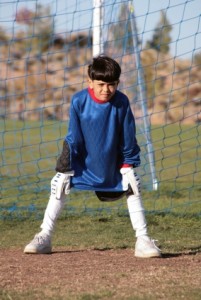In order to protect his goal from direct shots, a goalkeeper needs excellent reflexes. With a good handling technique  keeper should be capable of stopping most shots. However, careful positioning and anticipation will reduce the number of shots in the first place. Young players take time to develop this anticipation, but there are universal goal-keeping rules to follow to help make your players successful now as they develop their intuition for the game.
keeper should be capable of stopping most shots. However, careful positioning and anticipation will reduce the number of shots in the first place. Young players take time to develop this anticipation, but there are universal goal-keeping rules to follow to help make your players successful now as they develop their intuition for the game.
Before starting a game or practice drill, a keeper should check his basic position. This position will help him cope with the unexpected and enable him to run out and jump for a ball or make a diving save in the fastest possible time. He should stand with his feet about hip width apart, knees bent slightly and leaning his trunk forward from the hips. He should bend his arms so that his forearms are almost parallel with the ground about hip height. Finally, he must keep his eyes fixed on the ball, but also watch for any indication as to which way the ball is going.
In training, it’s best if goalkeepers have specialized coaching, whether they are kindergarten age, under 10, or even under 16 years old. While their team-mates work on their field skills, a keeper can work on his. One strength-building drill he can do is to lie on his back holding a ball on his chest. He can then push it hard into the air with both hands then jump to his feet as quickly as he can to catch it. He should be trying to jump to make the catch. As he improves, he can use a weighted medicine ball to make the exercise more strenuous.
Safety in handling the ball can’t be over-emphasized. No matter how sharp your keeper’s reflexes become they could let him down if he can’t hold the ball when he’s reached it. The best way of increasing safety when catching the ball is to provide a back-up barrier whenever possible. When stopping a low shot, for example, the feet and legs should be close enough together so as not to allow the ball to go through should it slip through his hands. Also, the stomach or chest should be well behind the flight of the ball when possible. For balls above the head, special care must be taken because it is impossible to back the hands with a second barrier. In this situation a keeper must make sure that the palms are right behind the ball and that the velocity is absorbed by allowing the hands to give slightly on contact.
When dealing with low shots, there are two ways to block them.
1) In the first method, the keeper should position his legs just a few inches apart and straight, bend his trunk forward and take the ball in front of the legs with the fingers and palms of both hands, which should be held close together. As the ball makes contact with the fingers and palms, its speed will make it roll up the forearms onto the body. Then, the keeper should straighten up, bending his elbows to bring the ball into his chest, clutching it firmly to prevent it bouncing off his body. The keeper should also watch the ball right into his hands.
2) The second method is safer because the whole body is behind the ball. This is performed by turning the hips slightly one way and kneeling on one knee. One knee should touch the ground just in front of the arch of the other foot so that there’s no way for the ball to get through if the keeper should make a mistake. The ball is taken in exactly the same way as the first method. This method might not be as popular as the first, but might work better on bumpy or wet playing conditions.
Remember to only work until your players appear tired. Working young players beyond this point can cause them to develop bad habits which they might bring to an important game.


No comments yet.